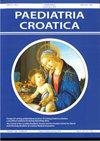神经母细胞瘤和威尔瘤--标准疗法
Q4 Medicine
引用次数: 0
摘要
本文介绍了神经母细胞瘤和威尔姆斯肿瘤的基本特征和治疗标准。这些肿瘤的发病年龄与较早出现有关。神经母细胞瘤多发于男孩,而肾母细胞瘤多发于女孩。疾病的定位和分期决定了临床表现。神经母细胞瘤多为转移性疾病,有可能发展为副肿瘤综合征,而 Wilms 肿瘤多为局部疾病。初步诊断决定了疾病的分期和风险,随后开始新辅助化疗。在重新评估后,进行手术,然后进行术后化疗。单侧 Wilms 肿瘤的手术治疗仍采用肾切除术。双侧 Wilms 肿瘤保留残余肾脏组织,并采用个体化方法。低危神经母细胞瘤可通过观察、化疗和手术治疗。治疗高危神经母细胞瘤时,可采用巨细胞疗法和自体干细胞移植,之后再采用免疫疗法和维甲酸疗法。放射治疗用于晚期威尔姆斯肿瘤和高危神经母细胞瘤。在治疗神经母细胞瘤时,还可以使用放射性同位素间碘苄基胍(MIBG)。神经母细胞瘤和威尔瘤治疗的基础是快速诊断和根据肿瘤疾病风险确定治疗强度,并使用适当的支持疗法。本文章由计算机程序翻译,如有差异,请以英文原文为准。
Neuroblastom i Wilmsov tumor - standard liječenja
The paper presents the basic characteristics and standard of treatment for neuroblastoma and Wilms tumor. The age at which these tumors appear is related to an earlier age. Neuroblastoma occurs slightly more often in boys, while nephroblastoma occurs slightlymore often in girls. The localization and stage of the disease define the clinical presentation. Neuroblastoma occurs more often as a metastatic disease with the possibility of developing a paraneoplastic syndrome, while Wilms tumor occurs more often as a localized disease. After the initial diagnosis, which determines the stage and risk of the disease, neoadjuvant chemotherapy is started. After the reevaluation, an operation follows, followed by postoperative chemotherapy. Nephrectomy is still used in the operative treatment of unilateral Wilms tumor. The residual kidney tissue is preserved in the bilateral Wilms tumor and an individual approach is implemented. Low-risk neuroblastoma can be treated with observation, chemotherapy, and surgery. Megatherapy and autolo-gous stem cell transplantation are used in the treatment of high-risk neuroblastoma, followed later by immunotherapy and retinoid therapy. Radiotherapy is used in advanced stages of Wilms tumor and in high-risk neuroblastoma. The use of the radioactive isotope meta-iodobenzylguanidine (MIBG) is also possible in the treatment of neuroblastoma. Rapid diagnosis and intensity of treatment defined by the risk of tumor disease with the use of appropriate supportive therapy are the basis of care for neuroblastoma and Wilms tumor.
求助全文
通过发布文献求助,成功后即可免费获取论文全文。
去求助
来源期刊

Paediatria Croatica
医学-小儿科
CiteScore
0.20
自引率
0.00%
发文量
0
审稿时长
6-12 weeks
期刊介绍:
In the inaugural 1956 issue of the journal, the editor Dr Feđa Fischer Sartorius outlined the journal''s vision and objectives saying that the journal will publish original papers on the development, pathology, and health care of children from the prenatal period to their final biological, emotional and social maturity. The journal continues this vision by publishing original research articles, clinical and laboratory observations, case reports and reviews of medical progress in pediatrics and child health.
 求助内容:
求助内容: 应助结果提醒方式:
应助结果提醒方式:


